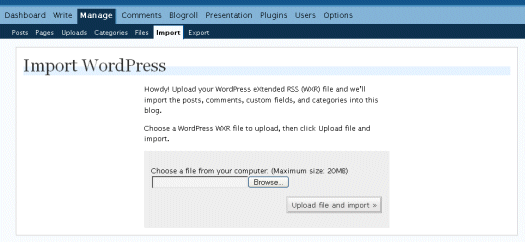WordPress MU, short for Multi-User, is a WordPress version that you probably have used without really knowing it. Automattic’s hosted blog service, WordPress.com, uses WordPress MU, although what you get when signing up with WordPress.com is pretty far from your basic WordPress MU install.
In other words, like most blog installs before plugins and nifty theming’s been added.
Choosing MU
I choose to build this on WordPress MU for one simple reason: I wanted to be able to create a beta blog in a few seconds, and MU let’s me do that.
Lately I’ve been doing a lot of WordPress MU work for a national blog network that I’ve founded. All is not done, but it’s launched over at pakten.se, if anyone’s up for some Swedish. The front page is one of the things on my todo-list by the way, so don’t judge me too hard now, eh? Links to the seven (as I’m writing this) blogs within the network is available in the top right, in the bar, if you want to click around.
I choose to build this on WordPress MU for one simple reason: I wanted to be able to create a beta blog in a few seconds, and MU let’s me do that.
A Whole New WordPress World?
Nope, it’s not. More or less every theme will work, and most of the plugins available. If you’re running a hosted WordPress installation, you can probably just move every extra little feature you’ve incorporated there, into a WordPress MU blog.
However, MU doesn’t have the ease that WordPress offers. Installation is still simple, permalinks a breeze, but there are a few things to consider. One being the fact that the MU community is small (or very silent), and documentation is poor at best. If you run into problems you’ll soon find yourself in the MU forums, and that’s far from the best way to find information.
Maybe I’m spoiled with the WordPress Codex wiki, a place that’s still valid since MU is basically WordPress for more users, but I thought twice before going with MU at all. Yes, I know, it’s opensource and everyone’s participating for free, yadayada – I can relate to that, and understand it. However, you won’t be having any users unless you offer decent documentation. I most certainly know my way around WordPress, but if I hadn’t I’d never dared to give MU a shot on a public project.
Pros and Cons with Using MU
Remember, this is assuming we’re using WordPress MU to power multiple blogs. If you want to offer your visitors a free blog, then MU really is your only WordPress option, since installing a WordPress blog for each person that wants to blog is tedious and slow.
WordPress MU supports most themes and plugins, as I stated above. It gets better, however. You can put plugins in a mu-plugin directory (much like you do with regular WordPress plugins in wp-content/plugins), and that means that they are automatically available and activated for all blogs.
Time saved for the multiple blogger. Nice.
That’s the good part. The bad part is that it doesn’t work with a lot of plugins, since no admin interface will show up, and if the plugin is manipulating the database, then forget about it. You can still put plugins in wp-content/plugins, however, and activate them manually for each blog. Just like you would if it was traditional stand-alone WordPress installs.
Themes are the same as with original WordPress, with the lone exception that you’ll have to activate them for usage in MU Admin, a new tab for administrators in WordPress MU’s admin interface.
So far so good, right? Sure, not every plugin can be activated in one place, but that’s a small price to pay for just having to update the blogging software on one place, and the same goes for plugins and themes of course.
Time saved for the multiple blogger. Nice.
Problems with MU
Yes, time saved indeed. There are, however, quite a few problems that you’ll have to overcome. Like editing core files for allowing certain tags to be used in the Post and Page writing fields in admin. Per default, you can’t even publish a YouTube video, since some of the tags the embed code uses get stripped away. I found quite a few things that I wanted to allow, since I’m in control of my own blogs – which was the whole purpose here.
Naturally, the not allowed tags are meant to protect the MU administrators when offering blogs for free, to anyone who wants ’em. Still, editing wp-includes/kses.php (where you’ll set allowed tags and so on) isn’t a small thing for someone not used to hacking som PHP. Not very user friendly.
Another problem I’ve had with MU is pinging, still unresolved. Per default, MU pings pingomatic.com, which is fine. I’d like to add more services though, which isn’t possible in admin – I can just add that one. As you might know, you can add just about how many you want in regular WordPress.
I have yet to find out how to add more ping services. Unfortunately, the small MU community haven’t been very helpful yet – and this is a problem I’d reckon could arise to quite a lot of people. What little documentation there is doesn’t help either. In fact, with all the “MU is just like WordPress so read the Codex” references that are out there, I could see users get pretty confused about these things, since pinging several services is a standard feature in WordPress.
(Do you know where I should look or what I should do to ping multiple services in WordPress MU? Get in touch, please!)
Final Verdict for Using MU to Power Multiple Blogs
I almost regret going with MU. It lacks the polish of regular WordPress, and the community is a lot smaller. I feel a lot more left out on my own here, than I did when I first ventured into WordPress.
However, the ease of which I can create blogs – allowing public creation or not – makes up for it. Just having to update on blog system, on set of plugins, that also saves me time.
While I wouldn’t pick MovableType over original WordPress, the lack of support and help for MU makes me wonder if there’s something better out there.
If you know your way around WordPress, and know a little about PHP, then WordPress MU is a good choice for powering multiple blogs. Otherwise you’ll have a hard time, or harder at least – MU isn’t as user friendly as original WordPress.
And by all means don’t expect your fresh WordPress MU install to look and feel like sleek WordPress.com. Then you’ll cry…
Finally, they say MovableType OpenSource will support multiple blogs in one install. It’s just available as a nightly build still, and I haven’t had the time to check it out, but if that’s true then WordPress MU is in for some serious competition. While I wouldn’t pick MovableType over original WordPress, the lack of support and help for MU makes me wonder if there’s something better out there.
Competition is good. Users will be the great gainers here.



